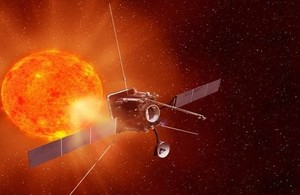Solar Orbiter
Discover UK involvement in the ESA Solar Orbiter mission to study our Sun.

Artist impression of Solar Orbiter in space approaching the sun [Credit: Airbus]
Overview
Solar Orbiter was selected as the first medium-class mission of ESA’s Cosmic Vision 2015-2025 Programme. The programme outlines key scientific questions which need to be answered about the development of planets and the emergence of life, how the Solar System works, the origins of the Universe, and the fundamental physics at work in the Universe.
Solar Orbiter aims to make significant breakthroughs in our understanding both of how the inner heliosphere works, and of the effects of solar activity on it. Solar Orbiter will measure solar wind plasma, fields, waves, and energetic particles close enough to the Sun to ensure that they are still relatively pristine.
The mission orbit will take the spacecraft on an ellipse around the Sun that will take it up to the Sun’s higher latitude. This will allow the solar features to be kept in view and tracked for several weeks.
Launched on 10 February 2020, the mission will provide close-up, high-latitude observations of the Sun. Solar Orbiter will have a highly elliptic orbit – between 1.2AU at aphelion and 0.28AU at perihelion.
The nominal mission duration is seven years, with the option to extend the mission by a further three years.
In January 2022, Solar Orbiter flew through the tail of a comet for the second time, and in February 2023 it caught a silhouette of Mercury transiting in front of the Sun.
For more detailed information, please see the Solar Orbiter pages on the ESA website.
Mission facts
The mission orbit is designed to be synchronous with the Sun’s rotation providing long duration observations for the first time. This will enable the mission to observe the build-up of events such as solar storms.
The instruments on board will undertake remote sensing observations of solar features and in situ measurements of the solar wind bombarding the spacecraft. This combination of remote and in situ instruments will enable in depth studies of the close link between the origin of solar features such as solar eruptions and their emergence into space. This unique mission could provide major breakthroughs in our understanding of how the inner solar system works and is driven by the solar activity.
The three-axis stabilised design of the spacecraft is being developed to withstand the scorching heat from the Sun that will hit one side and the cold of space on the opposite side which will usually be in shadow. The solar arrays are being engineered to provide the critical power supply without overheating.
Solar Orbiter is managed and financed mainly by ESA with strong international collaboration with NASA as part of the International Living with a Star initiative.
Technology
The Solar Orbiter spacecraft is based on the BepiColombo design reusing the technology developed for this previous mission. Additional heat protection will be added to enable it to operate in extreme thermal environments.
The instruments will be provided with cut-outs and doors in the heat shield. The instruments were selected jointly by ESA and NASA as part of the collaboration to provide the in situ and remote observations.
In situ instruments:
- SWA (Solar Wind Analyser)
- MAG (Magnetometer)
- RPW (Radio and Plasma Waves)
- EPD (Energetic Particle Detector)
Remote instruments:
- EUI (Extreme Ultraviolet Imager)
- SPICE (Spectral Imaging of the Coronal Environment)
- PHI (Polarimetric and Helioseismic Imager)
- STIX (X-ray Spectrometer Telescope)
- METIS/COR (Coronagraph)
- SolOHI (Heliospheric imager)
UK involvement
UK teams from University College London, Imperial College London, and Rutherford Appleton Laboratory, with funding from the UK Space Agency, are involved in 4 of the 10 instruments on Solar Orbiter.
Instruments onboard:
- SWA (Solar Wind Analyser) uses three sensors and a processing unit to measure the different elements of the solar wind and characterise their behaviour under different solar conditions. As Principal Investigators MSSL of the University of College London led the development of this instrument suite and built one of the sensors.
- MAG (Magnetometer) comprises two sensors located on a deployable boom in the shadow of the spacecraft, i.e., away from the Sun and an electronics box within the spacecraft body, enabling in situ sampling of the magnetic field and providing important diagnostic information. Imperial College London have led the development of this instrument.
- EUI (Extreme Ultraviolet Imager) is a suite of imaging telescopes that will provide images of the hot and cold layers of the solar atmosphere and of the solar corona showing the dynamics in fine detail and providing the link between the solar surface and outer corona. MSSL of the University College London is a Co-Investigator for this instrument.
- SPICE (Spectral Imaging of the Coronal Environment) is a telescope with a grating spectrograph and two active pixel sensor detectors that will provide images of the solar disk and corona. SPICE will be able to study features both on the surface and out in the corona and to look at the connection between them. Rutherford Appleton Laboratory is Principal Investigator for this instrument.
UK industry has played a key role in mission development. Airbus Defence and Space, based in Stevenage, was selected by the European Space Agency as the prime contractor for the mission and built the majority of the spacecraft. The contract carries a value of about €300 million, one of the largest ever signed between the ESA Science Programme and a UK company.
Updates to this page
-
Updated February 2023.
-
Updated information on Solar Orbiter mission
-
First published.